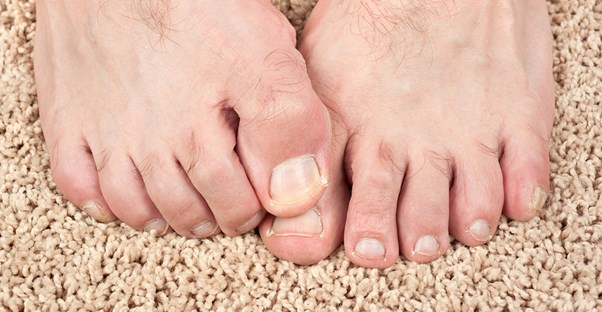Warm, moist environments like showers and locker rooms are a breeding ground for organisms that thrive in such places. Some of these organisms are fungi that invade the human body through cuts in the toes, cracks in the nail, or where the nail has become separated from the surrounding skin. Since shoes get hot and sweaty, the toenails become an ideal living space for things like dermatophytes, which cause toenail fungus.
Underlying Conditions
It can take years for toenail fungus symptoms to show up. The fungus may grow slowly, and the feet may be kept clean enough that it stays in check even if it’s present, but time allows for further exposure to increasing amounts of infectious microorganisms. Eventually, however, there will start to be obvious symptoms.
Because the toes receive less blood flow, it’s more difficult for the immune system to find and destroy infections there. This makes toenail fungus especially dangerous to those with immune or circulatory disorders, like HIV or diabetes. If you have an underlying disorder, and begin to notice a change in the shape, texture, or color of your toenails, it’s extremely important to see a doctor immediately.
Unhelpful Treatment
Although some people are at a higher risk, any healthy adult can contract toenail fungus. Since it does take so long to be visible, it can also take a long time to be problematic. Although you can help prevent development through careful hygiene, proper footwear, and other preventative measures, there are no assurances. If you notice discoloration, white patches, or thickness of the toenails, over the counter treatment may not be effective. The nails must be thinned gently using a file or with lotion containing urea, to allow topical medications to infiltrate the infection. If the use of nonprescription medications doesn’t seem to be helping, it’s time to head to a physician.
Obvious and Severe Symptoms
This can be particularly tricky, since the nail must grow out to be able to tell if things are improving. Over-the-counter creams can be touch and go, so some experts recommend going straight to the doctor, to ensure the most thorough treatment options. If the nail is becoming thick; has developed a crumbly, soft, or ragged quality; or is turning yellow, green, brown, or developing spots, the infection has definitely gotten a firm hold. These are all signs your doctor needs to take a look at things. If the infection spreads to other nails, the surrounding skin, other parts of the body, or is beginning to cause you pain, make an appointment as soon as you can.





